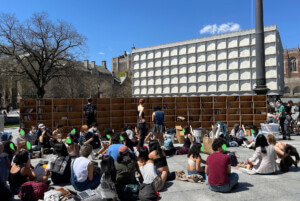Governor’s Island—a 172-acre landmass just 800 yards south of Manhattan—is a great testbed for innovating new technology in the face of global warming. Today, over one-tenth of the global population lives on islands, a number that is expected to grow amid rising sea levels. New York’s Governor’s Island has space and parameters that make it ripe for architects to explore new ideas for this imperiled condition, just look at the new climate-focused hub by SOM, New York Climate Exchange. Its relatively low level of infrastructure access challenges today’s architects to imagine future living where homes are lit by off-grid electrical solutions, communities have zero-waste, cyclical economies, locally-sourced building materials, and net-zero, regenerative infrastructure.
How can existing land scarce/water scarce island-based habitats inform future urban living amid climate change? Such is the point-of-departure for a new exhibition by students and faculty at Pratt Institute on Governor’s Island that opened this September. Part industrial design, part speculative form making, Adaptation(s) is a show at The Pratt House in Nolan Park on Governor’s Island co-curated by Jing Liu, founding partner of SO – IL and academic coordinator for Pratt’s Master of Science in Architecture Program. Pratt faculty members Jeffrey Anderson, Beatrice Galilee, and Poyao Shih were also foundational to the show’s programming.

The work undertaken by Pratt students is unconventional by design for unprecedented times. Rather than their research culminating in drawings or papers, students were asked to turn their research into prototypes that double as built objects and manifestos. One object on display posits a more ecological approach to burial practices, another is a radical new way of building brick out of locally-sourced materials. “We were interested in introducing students to alternative ways of adaptation, showing them how transformation can happen on a smaller scale,” Liu told AN.
At The Pratt House, speculative technologies developed by Pratt students coalesce with architectural models by SO – IL that demonstrate the award-winning studio’s commitment to sustainable, collective living. This ephemera appears alongside models and drawings by Bjarke Ingels Group (BIG) showing the firm’s proposal to fortify Manhattan’s coastline from rising water levels courtesy of Kai-Uwe Bergmann, a principal at BIG who worked with Liu to bring the show to life. Research depicting how countries around the world have adapted to rising sea levels appear next to the models by students, SO – IL, and BIG; rendering The Pratt House as a hotbed of bustling ecological brainpower.

“Many curricula and research centers at various universities have been focused mostly on mitigation and how to stop climate change,” said David Erdman, director of Pratt Institute’s Center for Climate Adaptation, who co-curated the show. “That is really important work, but Pratt as a research institution wants to find opportunities that are design forward. Applied research and climate adaption are some of those arenas,” Erdman told AN.
Three years ago, Erdman helped procure the building for Pratt Institute. He’s since driven Pratt House’s programming and direction, and helped coordinate Pratt’s engagement with Pace University, Stony Brook University, and the other organizations with facilities on Governor’s Island.
The Pratt House doesn’t have the same frills as design exhibition spaces in New York architects may be familiar with. It’s an old Victorian, two-story home built in 1843. Thus, the work on display there appears casual, friendly, and conversational. It’s perhaps the space’s domesticity that encourages symmetrical exchange between the audience and artists, as though they’re having coffee in a friend’s living room. It’s clearly a space for dialogue rather than didactic explanation, the kind of environs that real innovation and ingenuity demands.
In line with the domestic motif, even the drapes at Pratt House double as architectural drawings, depicting a new residential project by SO – IL in Brooklyn, 450 Warren Street. “We’ve been thinking a lot about the future of museums,” Liu said. “At Pratt House, we tried to make people feel at home and comfortable touching the objects.”

In the New York Climate Exchange, Pratt Institute is a core partner alongside Stony Brook University and academic and industry partners. Adaptation(s) is in collaboration with Singapore University of Technology and Design, The Trust for Governor’s Island, Pace University, and Henk Ovink, the founder of Rebuild By Design and former special envoy for Water Kingdom of the Netherlands.
The show features work by Pratt Institute students Aamir Makda, Arpsanah Kohli, Isha Shah, John Lin, Maitreyi Purandare, Nima Shiva, Sandhra Sajeev, Stanley Huang, Vatsal Patel. Research graduate assistants Patrick Rutan, Emily Young, Julia Young, Isaac Xu, and Emily Lawranson; and graduate assistants Mari Sparacino, Rida Khan, Aysin Bahar Sahin, and Sami Mohamed also participated. It was organized by Alex Barker, chairperson of Pratt Institute GAUD; Allison Druin, vice provost for Research and Strategic Partnerships at Pratt; David Erdman; Adam Friedman, the chief strategy officer for Pratt’s provost’s office for research and strategic partnerships; Quilian Rano, dean of the Pratt Institute School of Architecture; and Alexandra Zernik, Pratt Institute research and strategic partnerships coordinator. Poyao Shih, special projects coordinator at Pratt GAUD, helped coordinate the exhibition.
Adaptation(s) is on display through October 29.











